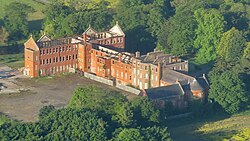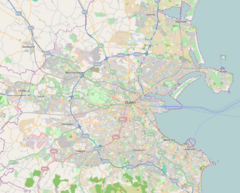
Leinster House is the seat of the Oireachtas, the parliament of Ireland. Originally, it was the ducal palace of the Dukes of Leinster. Since 1922, it has been a complex of buildings of which the former ducal palace is the core, which house Oireachtas Éireann, its members and staff. The most recognisable part of the complex, and the "public face" of Leinster House continues to be the former ducal palace at the core of the complex.

Swords, the county town of Fingal, is a large suburban town on the east coast of Ireland, situated ten kilometres north of Dublin city centre. The town was reputedly founded c. AD 560. Located on the Ward River, Swords features Swords Castle, a restored medieval castle, a holy well from which it takes its name, a round tower and a Norman tower. Facilities in the area include the Pavilions shopping centre, one of the largest in the Dublin region, a range of civic offices, some light industries, the main storage facility and archive of the National Museum of Ireland and several parks. Dublin Airport is located nearby.

James Hoban was an Irish-American architect, best known for designing the White House.
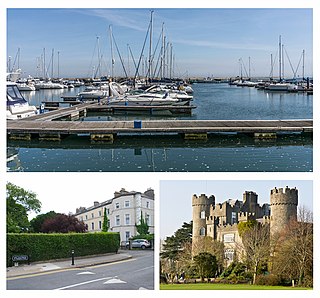
Malahide is an affluent coastal settlement in Fingal, County Dublin, Ireland, situated 14 kilometres (9 mi) north of Dublin city. It has a village centre surrounded by suburban housing estates, with a population of 18,608 as per the 2022 census.

Sutton is a residential suburb on the Northside of Dublin, Ireland. It occupies the tombolo which links Howth Head to the mainland, some of the lower slopes of Howth Hill, and a little of the adjacent coasts. The area lies within the jurisdiction of Fingal County Council. There is a small commercial core at the Sutton Cross road intersection.

Coolock is a large suburban area, centred on a village, on Dublin city's Northside in Ireland. Coolock is crossed by the Santry River, a prominent feature in the middle of the district, with a linear park and ponds. The Coolock suburban area encompasses parts of three Dublin postal districts: Dublin 5, Dublin 13 and Dublin 17.
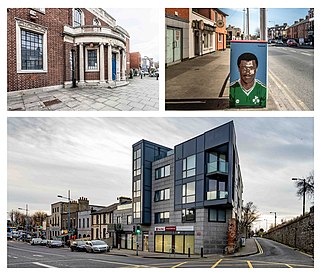
Inchicore is a suburb of Dublin, Ireland. Located approximately 5 kilometres (3.1 mi) west of the city centre, Inchicore was originally a small village separate from Dublin. The village developed around Richmond Barracks and Inchicore railway works, before being incorporated into the expanding city bounds. Inchicore is a largely residential area and is home to the association football club St Patrick's Athletic FC.

Baldoyle is a coastal suburb of Dublin's northside. It is located in the southeastern part of the jurisdiction of Fingal, Ireland, developed from a former fishing village.

Mount Temple Comprehensive School is a secondary school in Clontarf, Dublin, Ireland. The school operates under the patronage of the Church of Ireland Archbishop of Dublin, and has, as a primary objective, the provision of state-funded second-level education to the Protestant population of northern Dublin, while accepting pupils of all religions and none. The school was established in 1972 following the amalgamation of Mountjoy School, Royal Hibernian Marine School in coastal Clontarf, and Bertrand & Rutland School.
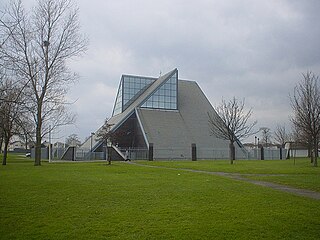
Donaghmede is a mixed socio-economic residential suburb on the northern side of Dublin, Ireland, formed from parts of Baldoyle, Coolock and Raheny in the 1970s. It contains a mid-size shopping centre and a ruined chapel, and lies within the jurisdiction of Dublin City Council.

Darndale is a working-class area on the Northside of Dublin, in Ireland, featuring a high concentration of social housing. It is located in the north of the sprawling suburb of Coolock. Darndale lies within the Dublin 17 postal district.
Balgriffin is a suburb of Dublin, Ireland. It lies on the administrative boundary between Dublin City and the county of Fingal in the traditional County Dublin.

Belmayne is a development of housing, and adjunct facilities, in Balgriffin, a northern outer suburb of Dublin, Ireland, commenced in 2006–2007.

Clongriffin is a community in northern Donaghmede, on the northern fringe of Dublin, Ireland. The settlement was based on a master plan vision from major developer Gannon Homes, with significant investment in transport infrastructure and also community and recreational amenities. Development slowed during the downturn in the economy, although activity renewed in recent years, with planning permission secured for a hotel and a range of additional homes including a 16-storey apartment block with residential lounges and roof gardens..
Priorswood is a townland and district in northern Coolock, on the Northside of Dublin, Ireland. It is in the jurisdiction of Dublin City Council and forms part of the Dublin 17 postal district.
Gerry Gannon is an Irish builder and property developer since the 1980s. Gannon played a significant role in the Irish construction industry in the lead up the bursting of the Irish property bubble. Gannon was one of the key figures involved in the Anglo Irish Bank hidden loans controversy, which was a contributing element in the development of the post-2008 Irish banking crisis.
Sir Edward Newenham (1734–1814) was an Irish politician.
Thomas Scully OMI was a Gaelic football manager, priest and schoolteacher. He managed the Offaly county team, where he was pivotal in establishing them as a rising side in the sport.
